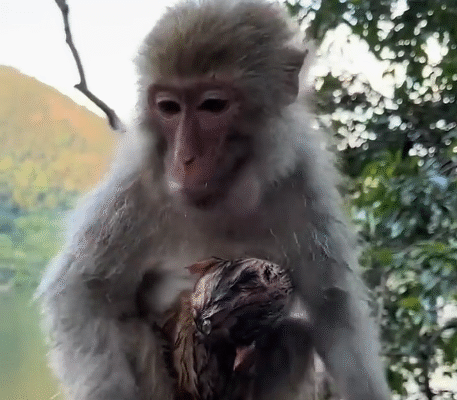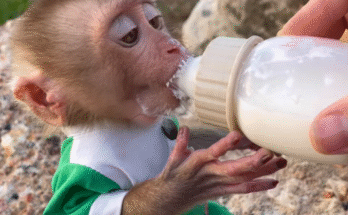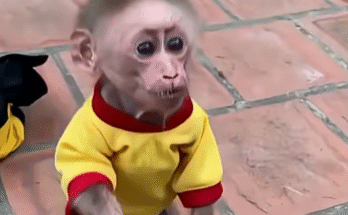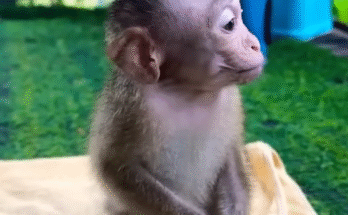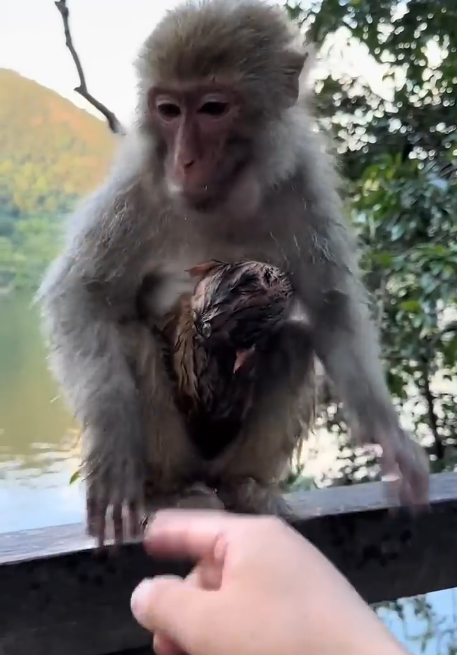
The sun had barely risen over the lush green hills when the jungle began to stir. Birds sang their morning songs, leaves rustled softly in the breeze, and high in the treetops, the monkey families awoke to another busy day of play, foraging, and mischief. Among them were the little baby monkeys, small bundles of energy with bright eyes and endless curiosity.
They were adorable beyond words—swinging from their mothers’ tails, chasing butterflies, and learning the ways of the forest one tumble at a time. Their innocence and playfulness made everyone who saw them smile. But for those who visited or worked near the sanctuary, there was one golden rule that had to be respected above all else:
👉 “Do not touch the little monkeys.”
It wasn’t said out of cruelty or distance—it was a rule born from deep care, respect, and the understanding of what these tiny creatures truly needed to survive and thrive.
A Sanctuary Full of Life
The story begins in a small wildlife sanctuary tucked deep in Southeast Asia, surrounded by thick jungle and ancient trees. It was home to dozens of rescued monkeys—some abandoned as pets, others injured by traps or taken from illegal wildlife trade.
Among the staff was Maya, a young caretaker with a gentle heart and a smile that could calm even the most nervous animals. She had come to the sanctuary to make a difference, and every day she worked tirelessly—cleaning enclosures, preparing food, and helping the veterinarians care for the injured.
Her favorite part of the day was when the sun softened and the monkeys came close to play in the open area near the feeding station. It was there that she first met Lulu, a newborn baby monkey with big round eyes and a fuzzy head of golden-brown fur. Lulu clung tightly to her mother, peeking out shyly as the older monkeys chattered and swung nearby.
From that moment, Maya fell in love with her.
The Temptation to Touch
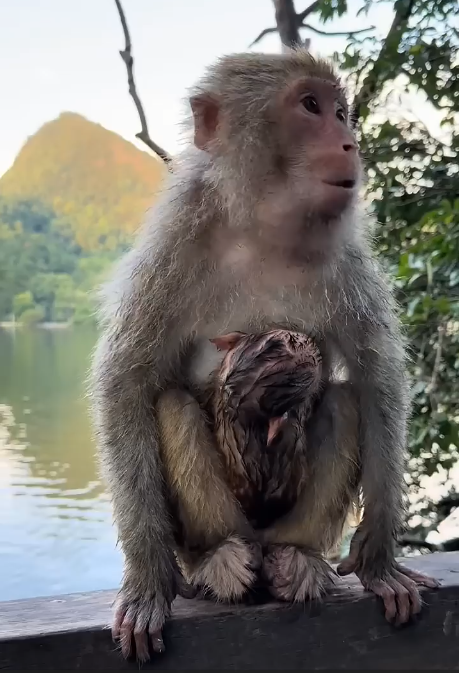
Every human who saw the baby monkeys felt the same irresistible urge—to reach out and hold them, just for a moment. They were so small, so fragile, and so full of life that it was easy to forget the rule.
One afternoon, a group of visitors came to the sanctuary. They watched with wide eyes as the monkeys played near the fence, laughing as the little ones rolled around in the grass. A woman whispered, “Oh my goodness, look at that one! She’s so cute! Can I hold her?”
Maya smiled kindly but shook her head. “I know it’s tempting,” she said gently, “but we’re not allowed to touch the little monkeys. It’s for their own safety—and ours too.”
The woman looked surprised. “Why not? I wouldn’t hurt her!”
Maya knelt down beside her and pointed toward the trees where a mother monkey sat, watching intently. “See her? That’s the baby’s mom. If she thinks you’re a threat, she’ll attack to protect her baby. And more importantly, if humans touch the babies, they can lose their mothers’ trust—or even their place in the group.”
The visitors nodded slowly, realizing the deeper truth behind the rule.
The Bond Between Mother and Baby
In the world of monkeys, the bond between a mother and her baby is sacred. From the moment a baby monkey is born, its mother carries it everywhere—on her belly as she climbs, on her back as she runs, even while she eats.
That closeness builds the baby’s sense of safety and belonging. But if a human interferes, even with good intentions, that natural bond can be damaged. The scent of human skin can confuse the mother, sometimes causing her to reject or abandon her baby.
Maya had seen it happen once before. A volunteer, new and unaware, had gently lifted an orphaned baby to comfort it. The moment he set it back down, the nearby female monkeys turned hostile—rejecting the baby as “different.” The little one had to be hand-raised by caretakers after that, growing up without learning the vital skills a mother would have taught.
From that day on, the sanctuary reinforced the rule even more strictly:
No one touches the babies. Ever.
Learning to Love Without Touching
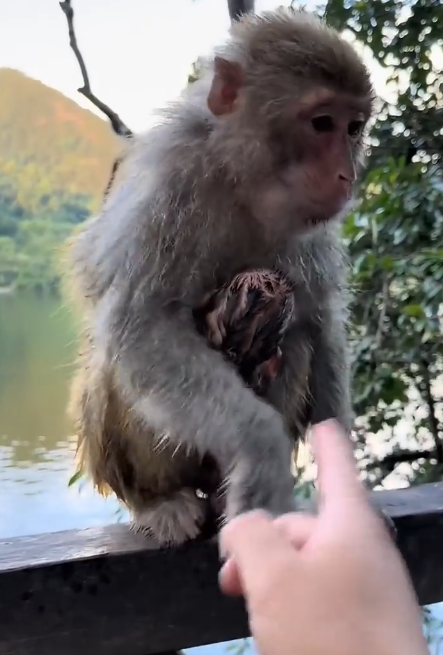
Despite the rule, the caretakers still found ways to connect with the monkeys. They watched, learned, and loved them from a respectful distance.
Maya learned that love isn’t always about holding or touching—it’s about understanding and protecting.
She began observing Lulu and her mother every day, noting their habits and personalities. Lulu was curious and bold—often venturing a little too far from her mom, testing her courage. Her mother would scold her with a sharp bark, pull her back close, and groom her fur gently afterward.
Sometimes, Lulu would lock eyes with Maya through the fence, tilting her tiny head as if to say, Who are you, funny human?
Maya would smile and whisper softly, “Grow strong, little one. You’re safe here.”
That was their silent bond—a friendship built without touch, only trust.
The Risk of Human Contact
The rule also protected humans. While monkeys may look sweet, they are still wild animals. A frightened mother or protective adult can lash out unexpectedly. Even baby monkeys can carry diseases that humans aren’t immune to.
Moreover, constant human contact can lead to dangerous dependency. Monkeys raised with too much human affection often struggle to survive when reintroduced into the wild. They forget how to socialize properly with their own kind and become too reliant on people for food and comfort.
At the sanctuary, the goal was always rehabilitation—not captivity. Each monkey was there to heal, learn, and eventually return to the forest if possible. Keeping their natural instincts intact was the most loving thing humans could do.
When Touch Is Necessary
There were rare moments when the caretakers did have to touch the little monkeys—but only when absolutely necessary, like during medical care or emergencies.
Once, during a heavy rainstorm, a tree branch fell near the enclosure, separating Lulu from her mother. The little one screamed in fear, clinging to the wire fence as thunder rolled overhead. Maya’s heart pounded—this was one of those times when rules had to bend for safety.
With careful hands, she lifted Lulu and carried her to a sheltered area until her mother could be brought back. Lulu trembled against her chest, tiny heart racing, her little hands gripping Maya’s shirt.
When the storm calmed and her mother returned, Maya placed Lulu gently back. The reunion was immediate—the mother wrapped her arms around her baby and held her tight, grooming her fur and calming her cries.
Maya stepped back, tears in her eyes. “That’s why we don’t touch,” she whispered. “Because their real comfort comes from each other.”
Understanding the Rule
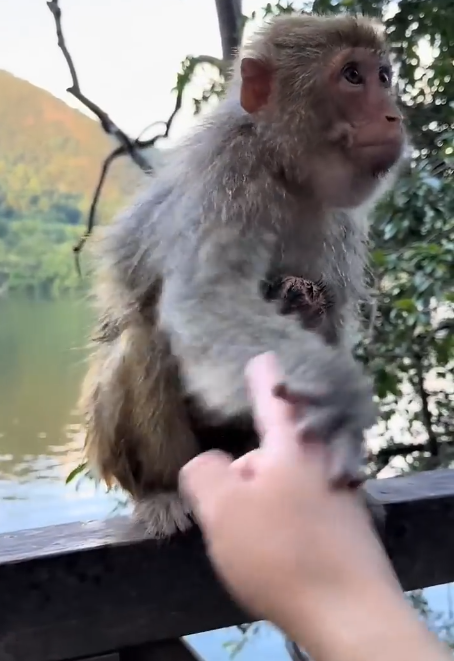
Over time, visitors came to understand what Maya and her team were teaching. The sanctuary wasn’t just a place to see animals—it was a place to learn from them.
Children were especially curious. One young boy asked, “So if we can’t touch them, how do we show them we love them?”
Maya smiled and replied, “By keeping them wild. By respecting them enough to let them be who they are.”
It was a lesson that extended far beyond the monkeys—it was about all living beings. Love, after all, doesn’t always mean closeness. Sometimes, it means giving space.
The Beauty of Respect
Months passed, and Lulu grew stronger, climbing higher in the trees and playing with the other young monkeys. One day, the sanctuary celebrated as several rehabilitated monkeys, including Lulu’s mother, were released back into the wild.
Maya stood at the edge of the forest, watching as Lulu turned one last time before following her mother into the trees. Her heart ached, but she knew this was the true meaning of care.
“No more cages,” she whispered. “No more fear. Just freedom.”
The forest echoed with the sound of monkeys calling to one another, their voices blending with the wind and the rustle of leaves—a chorus of life, untouched yet deeply loved.
The Lesson
The rule “Not allowed to touch little monkeys” may sound simple, even strict. But behind it lies a powerful truth: that the best way to protect something wild and beautiful is to let it stay wild and beautiful.
For Maya and all who loved those tiny creatures, respect was the truest form of love.
And somewhere, deep in the forest, a young monkey named Lulu swung from tree to tree, free and fearless—living proof that sometimes, love means letting go of the urge to touch and instead choosing the grace to simply watch, protect, and cherish from afar.
